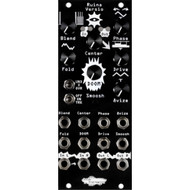Ruina Versio - Noise Engineering
by Brandon Ivers
Digital modules in Eurorack have long hinted at the infinite possibilities of flashable firmware, but they often trade usability for functionality. This is not always a bad thing—a module like Expert Sleeper’s Disting can do a staggering amount of things, but I don’t find these sorts of modules very fun to use. As such, my rule these days has been to avoid modules that require a reference manual for daily use, a choice that has been great for jamming, but often requires a lot more module swapping and case planning. Because of all this extra work, I’ve often wished for what seemed like a holy grail: a digital module with a decent UI that can contain many different firmware. Some have achieved this on paper, but none have really hit the nail on the head for me until Noise Engineering’s Versio range of digital effects.
So far, there are three main modules in Noise Engineering’s Versio lineup: Ruina Versio, Desmodus Versio, and Imitor Versio. The only real difference between each module is what firmware they already have pre-flashed and the labeling on the panel. Otherwise, the knobs are in the same spots and the inputs and outputs are the same. It’s a simple idea executed very well; there’s certain controls you almost always want on an effect [i.e. wet/dry] and those controls are always in the same spot, regardless of firmware.
The review module I received was a blank panel prototype simply called “Versio”, but I didn’t find this an impediment for use. My module was also pre-flashed with the “Ruina Versio” firmware [stereo distortion], and to be honest, that firmware kept me so busy that I just stuck with it for this review. At the time of writing, there are five total firmware available, so there’s really a ton to explore and each one probably deserves its own review.
Ruina’s interface uses seven main knobs, two switches, a SMOOSH button, and twelve jacks [four of which are dedicated to the mono/stereo inputs and outputs]. Your eyes will naturally be drawn to the DOOM knob in the middle because of the name, but I’d argue that the remaining controls are just as important, even if they aren’t called DOOM.
“Blend” is as I mentioned previously; a wet/dry knob that is absolutely critical for any distortion effect. “Fold” is a digital wavefolder which uses the same algorithm as found on Noise Engineering’s legendary Basimilus Iteritas Alter. “DOOM” is a sub-octave chorus that is a bit of a macro control: as you turn it up, your source becomes more detuned and overdriven. “Drive” is what you’d expect, but with a twist; it controls a multi-band saturator, and as you turn the knob, you sweep through, emphasizing one of four bands. “Phase” shifts the phase between the left and right channels, allowing you to create stereo effects [or even phaser effects if you get a bit more creative with modulation]. “8vize” controls a rectification distortion algorithm taken from NE’s Pura Ruina module. Finally, “SMOOSH” applies 128db of fixed gain which is obviously very important when obliterating a signal. All of this can be further massaged by two switches; the top switch controls the signal path of the distortion effects, while the second switch controls a notch filter, which can either sit at a fixed 1k frequency, or tracked via the ‘Center’ knob [which can be externally modulated as well].
All this control might seem overwhelming, but it’s clear Noise Engineering understands the tools you often need when working with distortion, particularly with electronic music. I found myself using every single control available, mainly because there are so many interesting interactions between the algorithms. For example, I found 808-style bass and kick drums particularly fun to sculpt with Ruina Versio because you can so easily sweep the notch filter around the fundamental of these sounds and get aggressively strange results by balancing the distortion algorithms in different ways. Try modulating the “SMOOSH” control with a gate, and you can create a distorted accent that can give nice variation to your weird distorted industrial loop. Meanwhile—for more typical synth sequences—subtle distortion paired with modulating “PHASE” with a slow LFO creates a natural sounding stereo image that can add a lot of life into a mono sound source. Blend to taste without having to use another module or two. The way the effect is organized, it sometimes reminds me of a very well-executed Ableton effect, but with actual knobs and easier modulation.
I should note that the effects that Ruina Versio excels at are very much digital in flavor. If you’re expecting anything like Noise Engineering’s previous analog “distortion of the month” offerings, you might want to look elsewhere. However, if you like the sound of clean digital wavefolding, or an almost surgical take on wild [but remarkably versatile] signal processing, I would highly recommend checking this out. I really don’t know of anything else that sounds quite like it. You can get some similar sounds with Trash 2 in the computer realm, but there’s still an edge here that is distinctly Noise Engineering. It’s been almost a month now, and I’m still not sick of the Ruina Versio firmware. With Versio’s remaining four algorithms to explore, I’d say this whole platform is a pretty fantastic value.
10 HP +12v 70mA -12v 70mA
Price: $350


